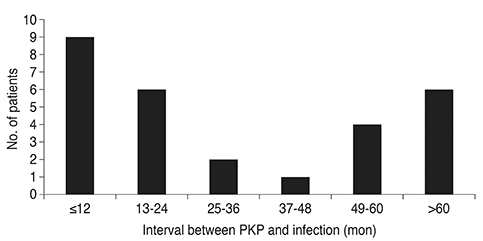Korean J Ophthalmol.
2015 Oct;29(5):301-308. 10.3341/kjo.2015.29.5.301.
Factors Affecting Treatment Outcome of Graft Infection Following Penetrating Keratoplasty
- Affiliations
-
- 1Department of Ophthalmology and Research Institute of Medical Sciences, Chonnam National University Hospital, Chonnam National University Medical School, Gwangju, Korea. kcyoon@jnu.ac.kr
- 2Department of Ophthalmology, Chonbuk National University Hospital, Chonbuk National University Medical School, Jeonju, Korea.
- KMID: 2363803
- DOI: http://doi.org/10.3341/kjo.2015.29.5.301
Abstract
- PURPOSE
To evaluate the factors affecting treatment outcome of graft infection following penetrating keratoplasty (PKP).
METHODS
In this retrospective study, 28 patients who underwent PKP between January 2005 and January 2013 and who were diagnosed with graft infection were classified into a treatment success group or a treatment failure group. Demographic and clinical characteristics, as well as the results of the microbiologic investigation, were analyzed and compared. A subsequent binary logistic regression analysis was performed to identify the prognostic factors affecting treatment outcome.
RESULTS
Graft infection occurred at a mean of 38.29 +/- 36.16 months (range, 1 to 96 months) after PKP. Seventeen patients developed bacterial keratitis, and 11 patients developed fungal keratitis. Overall, of the 28 patients, nine (32.1%) were classified in the treatment failure group. Multivariate analysis identified pre-existing graft failure (p = 0.019), interval longer than 72 hours between donor death and PKP (p = 0.010), and fungal infection (p = 0.026) as significant risk factors for treatment failure.
CONCLUSIONS
Pre-existing graft failure, extended interval between donor death and PKP, and fungal infection were important risk factors for treatment failure of graft infection following PKP.
MeSH Terms
-
Adult
Aged
Aged, 80 and over
Eye Infections, Bacterial/diagnosis/*etiology
Eye Infections, Fungal/diagnosis/*etiology
Female
*Graft Survival
Humans
Keratoplasty, Penetrating/*adverse effects
Male
Middle Aged
Prognosis
Retrospective Studies
Risk Factors
Surgical Wound Infection/diagnosis/*etiology
Treatment Outcome
Figure
Reference
-
1. Bates AK, Kirkness CM, Ficker LA, et al. Microbial keratitis after penetrating keratoplasty. Eye (Lond). 1990; 4(Pt 1):74–78.2. Wright TM, Afshari NA. Microbial keratitis following corneal transplantation. Am J Ophthalmol. 2006; 142:1061–1062.3. Wagoner MD, Al-Swailem SA, Sutphin JE, Zimmerman MB. Bacterial keratitis after penetrating keratoplasty: incidence, microbiological profile, graft survival, and visual outcome. Ophthalmology. 2007; 114:1073–1079.4. Leahey AB, Avery RL, Gottsch JD, et al. Suture abscesses after penetrating keratoplasty. Cornea. 1993; 12:489–492.5. Vajpayee RB, Sharma N, Sinha R, et al. Infectious keratitis following keratoplasty. Surv Ophthalmol. 2007; 52:1–12.6. Das S, Constantinou M, Ong T, Taylor HR. Microbial keratitis following corneal transplantation. Clin Experiment Ophthalmol. 2007; 35:427–431.7. Akova YA, Onat M, Koc F, et al. Microbial keratitis following penetrating keratoplasty. Ophthalmic Surg Lasers. 1999; 30:449–455.8. Gudmundsson OG, Ormerod LD, Kenyon KR, et al. Factors influencing predilection and outcome in bacterial keratitis. Cornea. 1989; 8:115–121.9. McLeod SD, LaBree LD, Tayyanipour R, et al. The importance of initial management in the treatment of severe infectious corneal ulcers. Ophthalmology. 1995; 102:1943–1948.10. Fong LP, Ormerod LD, Kenyon KR, Foster CS. Microbial keratitis complicating penetrating keratoplasty. Ophthalmology. 1988; 95:1269–1275.11. Harris DJ Jr, Stulting RD, Waring GO 3rd, Wilson LA. Late bacterial and fungal keratitis after corneal transplantation. Spectrum of pathogens, graft survival, and visual prognosis. Ophthalmology. 1988; 95:1450–1457.12. Armstrong M. The laboratory investigation of infective keratitis. Br J Biomed Sci. 1994; 51:65–72.13. Al-Hazzaa SA, Tabbara KF. Bacterial keratitis after penetrating keratoplasty. Ophthalmology. 1988; 95:1504–1508.14. Constantinou M, Jhanji V, Vajpayee RB. Clinical and microbiological profile of post-penetrating keratoplasty infectious keratitis in failed and clear grafts. Am J Ophthalmol. 2013; 155:233–237.e2.15. Srinivasan M, Gonzales CA, George C, et al. Epidemiology and aetiological diagnosis of corneal ulceration in Madurai, south India. Br J Ophthalmol. 1997; 81:965–971.16. Bharathi MJ, Ramakrishnan R, Vasu S, et al. Epidemiological characteristics and laboratory diagnosis of fungal keratitis: a three-year study. Indian J Ophthalmol. 2003; 51:315–321.17. Xie L, Zhong W, Shi W, Sun S. Spectrum of fungal keratitis in north China. Ophthalmology. 2006; 113:1943–1948.18. Tavakkoli H, Sugar J. Microbial keratitis following penetrating keratoplasty. Ophthalmic Surg. 1994; 25:356–360.19. Vajpayee RB, Boral SK, Dada T, et al. Risk factors for graft infection in India: a case-control study. Br J Ophthalmol. 2002; 86:261–265.20. Moorthy S, Graue E, Jhanji V, et al. Microbial keratitis after penetrating keratoplasty: impact of sutures. Am J Ophthalmol. 2011; 152:189–194.e2.21. Borderie VM, Scheer S, Touzeau O, et al. Donor organ cultured corneal tissue selection before penetrating keratoplasty. Br J Ophthalmol. 1998; 82:382–388.22. Doughman DJ, Van Horn D, Harris JE, et al. Endothelium of the human organ cultured cornea: an electron microscopic study. Trans Am Ophthalmol Soc. 1973; 71:304–324.23. McKinnon JR, Walters GD. Cadaver storage time. An important factor in donor cornea survival. Arch Ophthalmol. 1976; 94:217–220.24. Hagenah M, Simon B, Bohnke M. Experimental corneal cryopreservation: impact of postmortem time on corneal endothelial cell survival. Ophthalmic Res. 1993; 25:210–215.25. Pels E, Beele H, Claerhout I. Eye bank issues. II. Preservation techniques: warm versus cold storage. Int Ophthalmol. 2008; 28:155–163.26. Stocker FW. The endothelium of the cornea and its clinical implications. Trans Am Ophthalmol Soc. 1953; 51:669–786.27. Lalitha P, Prajna NV, Kabra A, et al. Risk factors for treatment outcome in fungal keratitis. Ophthalmology. 2006; 113:526–530.
- Full Text Links
- Actions
-
Cited
- CITED
-
- Close
- Share
- Similar articles
-
- Clinical Results of Penetrating Keratoplasty after Glaucoma Surgery
- Cataract Extraction after Penetrating Keratoplasty
- Risk Factors of Graft Failure in Post-Keratoplasty Ocular Hypertension
- Clinical Results of Graft Rejection Related to Graft Size after Keratoplasty in Keratoconus
- Clinical Evaluation of the Glaucoma after Penetrating Keratoplasty


